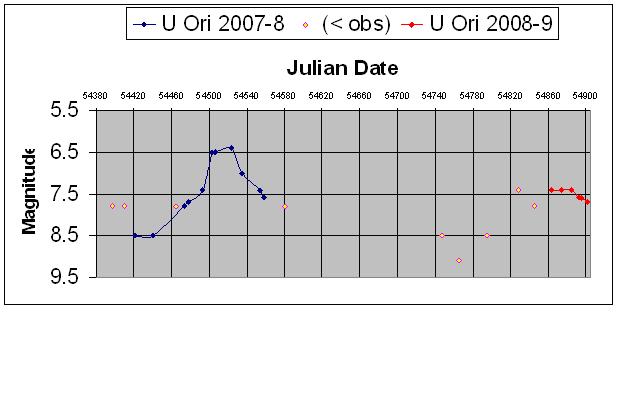U Orionis Observing Notes 2007-2009
The British Astronomical Association made U Orionis, a long-period variable or “Mira” star, its variable star of year for 2008. This star varies over a period of around 368 days, typically from magnitude 6.5 to 12.0. Like all long-period variable stars the period and range are not constant. The maxima for this star vary from about 5.0 to 7.1. Professional astronomers do not yet know why the size of maxima vary, and the data provided by amateurs over many decades will be a key to trying to find this out in the future.
Although in the constellation of Orion, this star is near the star Chi Orionis on the borders of Gemini, so actually has a declination of +20 and it is best found starting at Eta Geminorum. So it can be observed for quite a large part of the year from the UK (from mid-August to early May). The predicted maximum for 2009 was February 15th, and for 2010 is February 19th , so it is currently well placed for observation.
I observed it for two seasons, starting in September/October and finishing around May. In the autumn, I was not able to see it in my binoculars as it was too faint (these observations are marked in yellow on the diagram). I then followed it right through maximum successfully.
The diagram summarises my observations over 18 months.
U Orionis light curve 2007-9 Image Credit : Steve Woodbridge

2008 was a fairly typical maximum with a peak magnitude around 6.3. The rise to maximum is normally faster than the fall to minimum, as is typical with Mira stars, although this is not clear from my data. 2009 was a much fainter maximum, only about 7.4 and many observers (including myself) did not pick it up in binoculars until well into January.
In many ways Long Period variable stars are fun to watch as they do change in brightness so much. If society members (or others) want to join me in watching variable stars, I will be happy to give advice.
Some useful Links
British Astronomical Association (BAA) Variable star section
American Association of Variable Star Observers (AAVSO)
by Steve Woodbridge
Aug 2009
